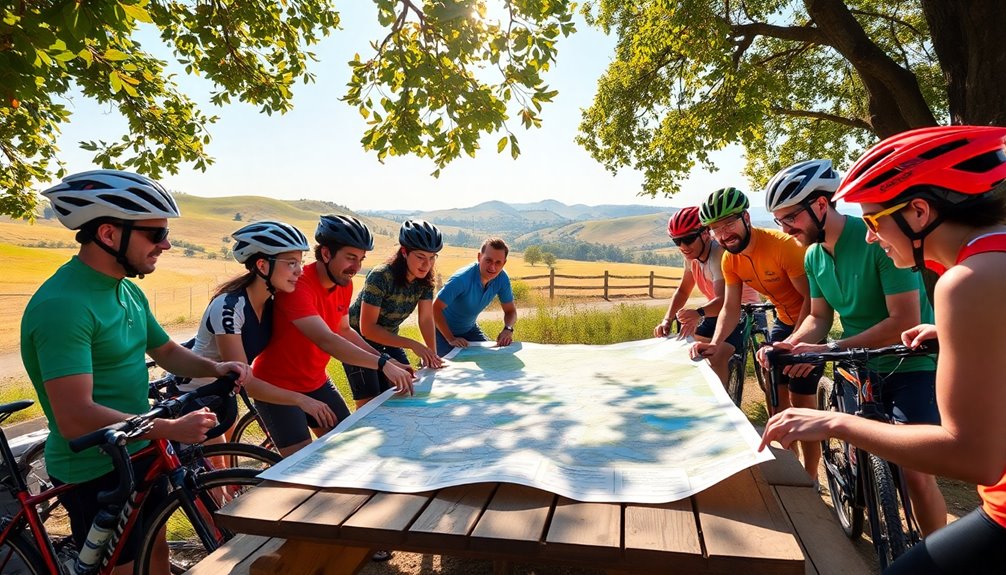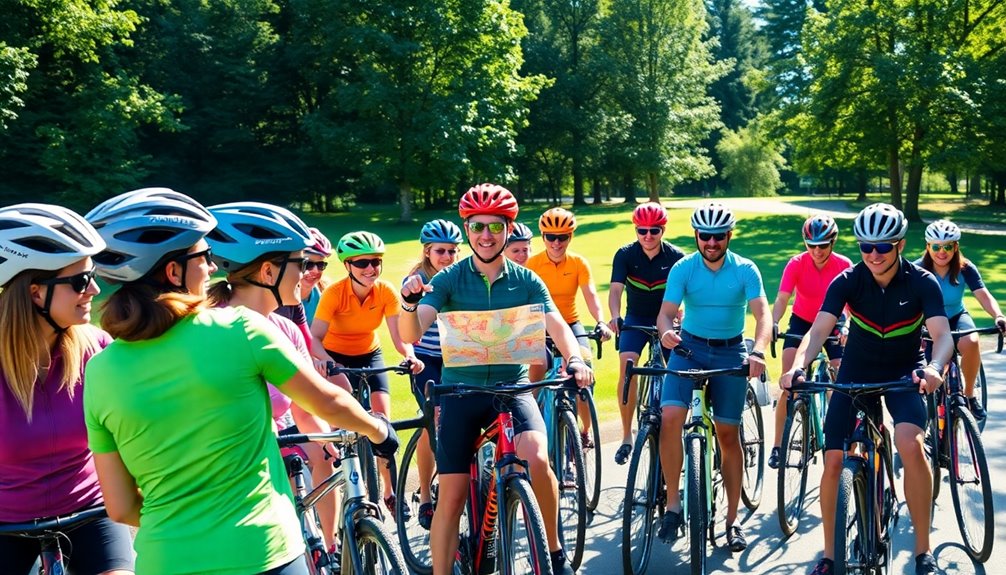To organize a successful group ride, start by setting clear objectives that match everyone's skill levels and expectations. Choose a safe, enjoyable route and communicate all necessary details upfront. Prioritize safety with proper etiquette, like using hand signals and maintaining a safe distance. Foster inclusivity by welcoming newcomers and pairing them with veteran riders. Keep the atmosphere friendly and supportive, and remember to plan for logistics, breaks, and weather changes. You'll discover even more tips to enhance your rides.
Key Takeaways
- Define the ride's purpose, pace, and distance based on participants' skill levels for a focused experience.
- Choose safe routes and plan rest stops for hydration and regrouping to ensure rider safety.
- Communicate logistics, including start times and route details, in advance to foster group enthusiasm.
- Foster a welcoming atmosphere by introducing newcomers and encouraging experienced riders to support them.
- Utilize mentorship from veterans to build confidence in new riders and promote camaraderie within the group.
Understanding Group Rides

When you join a group ride, you're stepping into an experience that emphasizes teamwork and collective pacing.
Group rides can vary from laid-back no-drop rides, where experienced riders guarantee no one gets left behind, to faster drop rides that challenge your pace.
Understanding cycling etiquette is vital; using hand signals and verbal cues helps communicate your intentions to others, enhancing safety and enjoyment.
Drafting is another key technique, allowing you to conserve energy by riding closely behind a leader, potentially saving up to 50% of your effort.
Remember, these rides typically start at predetermined locations and follow known routes, so familiarize yourself with them to guarantee a smooth experience.
Embrace the camaraderie and enjoy the ride!
Setting Objectives for Your Ride

Setting clear objectives for your group ride is essential for creating a focused and enjoyable experience. By defining your ride's purpose—whether it's for leisure, fitness, or skill development—you align expectations among participants. Consider the riders' skill level and tailor the pace, distance, and difficulty accordingly. Here's a quick reference table to help you set effective objectives:
| Objective Type | Example Goal |
|---|---|
| Purpose | Leisure, Fitness, Skill |
| Target Demographic | Beginners, Experienced Riders |
| Specific Goals | Improve Cohesion, Endurance |
| Route Characteristics | Safety, Scenery, Amenities |
Communicating these objectives in advance fosters enthusiasm and clarity, enhancing the overall ride experience for everyone involved. Additionally, consider implementing automated contributions to ensure consistent participation and commitment from all riders.
Choosing the Right Route

Choosing the right route for your group ride is essential to guarantee everyone has an enjoyable experience. Consider these key points:
- Skill Levels and Experience: Match the route's distance and terrain to the participants' abilities. Shorter, flatter routes work well for beginners, while experienced cyclists may prefer longer, challenging paths.
- Safety First: Avoid busy roads. Opt for designated bike paths or quieter backroads to enhance safety and the overall riding experience.
- Rest Stops and Hazards: Plan rest stops to allow hydration and regrouping.
Review the route for potential hazards like potholes or construction, and communicate these to the group to assure everyone's safety during the ride.
Communicating With Participants

How can you guarantee everyone's on the same page for your group ride? Start by clearly communicating the ride's pace, distance, and meeting point in advance. Use social media or local cycling forums to share these details and gauge interest, including any specific requirements for participants.
During the ride, establish a communication system with hand signals and verbal cues to alert everyone about hazards and changes in pace. As the ride date approaches, send reminders to address any last-minute questions or adjustments.
Encourage open dialogue about comfort levels and concerns during the ride, ensuring all participants feel included and supported. This way, everyone can enjoy the experience while riding together safely and confidently.
Safety and Etiquette Guidelines

While riding in a group can be enjoyable, prioritizing safety and etiquette is essential for a smooth experience. Here are some key guidelines to follow:
Prioritizing safety and etiquette is crucial for an enjoyable group riding experience.
- Wear a helmet and appropriate gear: This protects you in case of accidents and enhances your safety.
- Use hand signals and verbal cues: Clearly communicate road hazards, turns, and changes in group pace to keep everyone aware and safe.
- Maintain a safe following distance: Keep at least a bike length between you and the rider in front to prevent collisions and allow for sudden stops.
Remember to respect the group's pace, especially on no-drop rides, and adhere to basic cycling etiquette, like avoiding overlapping wheels, to enhance cohesion and minimize risks.
Promoting Inclusivity in Group Rides

When organizing group rides, it's essential to welcome new participants and make them feel at home.
You should adjust the pace and offer diverse route options to accommodate everyone, from beginners to seasoned cyclists.
Welcoming New Participants
Creating an inviting atmosphere for new participants is essential for promoting inclusivity in group rides. You can make newcomers feel welcome and comfortable by taking these steps:
- Introduce Yourself: Make it a point to greet every new person, and encourage experienced cyclists to do the same. This helps ease any anxiety they might feel on their first group ride.
- Engage During the Ride: Check in with new riders about their comfort levels and offer support, like spare water or route tips.
- Designate Mentors: Assign experienced cyclists as mentors to help new people navigate group dynamics and improve their skills.
Adjusting Pace Accordingly
Making new participants feel welcome sets the stage for a positive group experience, but it's equally important to guarantee everyone can keep up during the ride.
Adjusting pace is essential to accommodate varying skill levels, ensuring that no rider feels left behind. Implement a no-drop policy where the group pauses for slower riders at predetermined points. This fosters an inclusive atmosphere.
Regularly check in with less experienced cyclists to gauge their comfort and adjust the pace accordingly. Designate a ride leader to maintain a manageable pace for all participants.
Before the ride, encourage open communication about pace preferences. Incorporating shorter distance options or breaks along the route helps everyone recover and keeps the group cohesive, enhancing camaraderie among participants. Additionally, consider changing gears appropriately to help all riders maintain a comfortable cadence on varying terrain.
Offering Diverse Route Options
Offering a variety of route options can greatly enhance the inclusivity of group rides, guaranteeing that everyone finds a path suited to their abilities. By providing routes tailored to different skill levels, you foster a welcoming environment.
Here are three key considerations:
- Diverse routes: Offer shorter, flatter paths for beginners and longer, challenging rides for experienced cyclists.
- Safety measures: Prioritize designated bike paths or quieter roads to guarantee participant safety and comfort.
- Effective communication: Clearly share route details, including distance and terrain, so riders can make informed choices about their participation.
Encouraging mentorship from experienced riders to beginners can further support inclusivity and skill development, creating a positive atmosphere for all involved.
Planning for Logistics

When planning a group ride, it's important to take into account logistics to guarantee everyone has a smooth experience.
Start by arranging transportation options to make certain participants can easily reach the meeting points. During the ride, provide snacks and water to keep everyone energized and hydrated, especially for longer distances.
Arrange transportation for easy access to meeting points and provide snacks and water to keep everyone energized during the ride.
Designate rest stops along the route, allowing cyclists to take breaks, regroup, and refuel. Always have a backup plan in case of inclement weather, such as an alternative route or rescheduling the ride.
Make certain to clearly communicate all logistical details, including start times and route information, ahead of time. Effective communication helps everyone feel prepared and excited for the ride!
Encouraging New Participants

To encourage new participants, you'll want to create a welcoming atmosphere from the start.
Make an effort to introduce yourself and engage with newcomers, while encouraging experienced riders to lend their support.
Welcoming Atmosphere Creation
How can you create a welcoming atmosphere for new participants in your group rides?
It's crucial to foster a comfortable environment where everyone can connect. Here are three effective ways to achieve this:
1. Personal Introductions: Greet each new rider and encourage them to share their riding experience and goals.
This helps them feel valued and connected to the group.
2. Mentorship Pairing: Involve experienced riders in welcoming efforts by pairing them with beginners.
This support can make newcomers feel more comfortable during the ride.
3. Positive Encouragement: Maintain a friendly attitude and celebrate small achievements throughout the experience.
Acknowledging efforts builds community and encourages participation in future rides.
Engaging Newcomers Actively
Why should newcomers feel like they belong right from the start? You can create an inviting atmosphere by introducing yourself and engaging them in conversation.
Encourage experienced riders to welcome newcomers, pairing them for guidance and support. Use group introductions to foster a sense of community, helping new participants feel comfortable in the cycling environment.
Throughout the ride, monitor their comfort levels, adjusting the pace or offering assistance as needed to guarantee they enjoy the experience.
Incorporate icebreakers or casual conversations during breaks to ease anxiety and promote camaraderie.
Mentorship From Veterans
When experienced cyclists step up as mentors for newcomers, it creates a supportive atmosphere that enhances everyone's riding experience. By pairing veterans with beginners during group rides, newcomers can learn from more experienced cyclists while gaining confidence in their skills.
Here are a few ways to foster this mentorship:
- Buddy System: Pair veterans with beginners, guiding them through group dynamics and cycling etiquette.
- Pre-Ride Meetings: Host discussions where veterans share tips, answer questions, and prepare newcomers for the ride ahead.
- Skill Sessions: Create opportunities for veterans to lead training on essential skills like hand signals and paceline riding.
Recognizing veteran mentors not only supports new riders but also strengthens the cycling community, ensuring everyone enjoys the ride.
Frequently Asked Questions
How to Organize a Group Ride?
To organize a group ride, start by selecting a route that suits everyone's skill levels, keeping safety in mind.
Set a clear meeting point and time, sharing details about the pace and duration.
Promote the ride through local shops and social media to attract diverse participants.
Prepare logistics like snacks and transportation.
Finally, create an inclusive atmosphere by encouraging experienced riders to help beginners, ensuring everyone feels comfortable and supported throughout the ride.
What Is the 75 Rule in Cycling?
The 75 Rule in cycling is all about maintaining your effort at 75% of your maximum heart rate for ideal endurance.
You can calculate your maximum heart rate by subtracting your age from 220.
By following this rule, you'll find a balance between intensity and sustainability, building your endurance without overdoing it.
It helps prevent fatigue and injuries, making it a smart choice for those long rides you're planning.
What Is the Recommended Maximum Number of Riders in a Group?
The recommended maximum number of riders in a group ride usually ranges from 10 to 20 participants. Keeping it within this limit helps guarantee safety and effective communication.
If you're in a competitive ride, aim for 8 to 12 riders to maintain better dynamics.
For beginner-friendly, no-drop rides, capping at 15 is ideal to provide support.
What Is the Cycling Group Rule?
The cycling group rule focuses on maintaining cohesion by adjusting your speed to match the group's pace, especially in no-drop rides.
You should communicate effectively with hand signals and verbal cues to alert others about hazards and turns. Always follow a predictable line and keep a safe distance to avoid collisions.
Additionally, take turns at the front during pacelines to help reduce wind resistance while allowing others to rest at the back.
Conclusion
In conclusion, organizing a group ride can be a rewarding experience. By understanding your riders, setting clear objectives, choosing the right route, and communicating effectively, you create an inclusive environment. Prioritizing safety and etiquette guarantees everyone feels secure, while planning logistics keeps things running smoothly. So, embrace the thrill of adventure, foster connections among participants, and encourage newcomers to join in. Together, you'll build lasting memories and a vibrant cycling community, one ride at a time.









